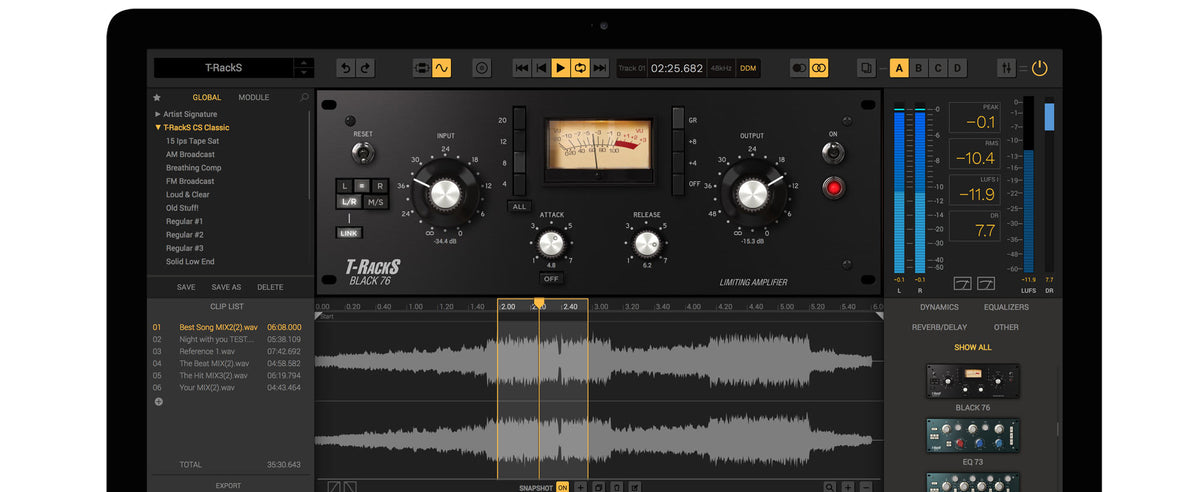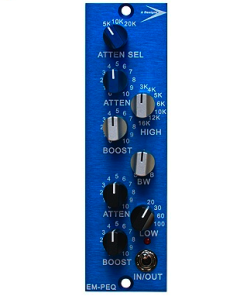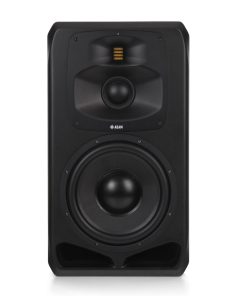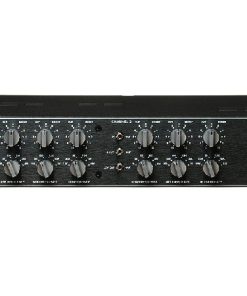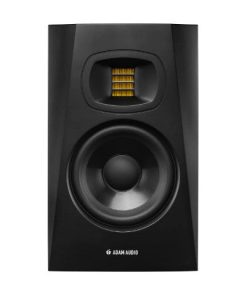IK Multimedia Black 76 LA – Limiting Amplifier Plug-In IK Multimedia
$ 124,99 $ 50,00
Timeless, classic compression
The Black 76 Limiting Amplifier is modeled after what is probably the most used, most known and most universally recognized compressor/limiter in the audio industry. There are probably no professionally recorded tracks where this unit wasn’t used. It’s a true legend and a piece of music production history.
The engineers that made this FET based compressor reached a level of cleverness and magic that only true visionary geniuses can achieve. While there are many revisions of this hardware, we modeled the LN version, revision E, because it’s the one that has the most sonically recognized and sought after character thanks to its input transformer and class A output stage.
All of its features have been closely modeled, from its lightning fast attack, a peculiarity of this model, to the “all buttons in” mode: this is a trick that engineer use to create some pretty intense and wild effects, since when all ratio buttons are pressed together distortion drastically increases due to continuous and radical time constants shifts; this is a good way to hit room tracks hard or smack parallel busses for distinctive sonic signatures.
It’s also a “go to” unit for standard compression duties, thanks to the quality of the sound it imparts to a track, even when not compressing, and to the simplicity of its controls: just set the input and output level to get in the ballpark of how much gain reduction is needed, then once set the Ratio the compression is quickly fine tuned with the time constants controls.
It is difficult to find a track or source where this compressor won’t sound good; it is practically able to give authority and personality even to the most sterile track; bass is one of the most common uses for this plug-in but its very fast attack makes it very handy on percussive sources, like snare drum; vocals will benefit from its solid compression, standing out in the mix with presence and boldness. It’s not out of the ordinary to see a pair of these compressors stereo-linked across the main bus of a mixer, so the fact that the T-RackS model is either mono or stereo makes it easy to replicate this technique.
When the preamp is disengaged the Gain and Out controls act as clean input and output levels to the EQ section for handy adjustments.
Also included in
- T-RackS 5 SE
- T-RackS 5 Deluxe
- T-RackS 5 MAX
- Total Studio 3 SE
- Total Studio 3.5 MAX
Specs
- Works within the T-RackS CS Standalone application and as plug-in
- High-quality oversampling
- High-precision and high-transparency digital processors
- Accurately analog-modeled vintage classic devices
- Full-latency compensation support
- Supports sampling rates up to 192 kHz
- DSM™ and SCC™ proprietary IK technologies for extremely accurate digital models of analog hardware devices
- Native compatibility with 64-bit applications and operating systems
System Requirements
T-RackS 5 is a 64-bit application and requires a 64 bit CPU and Operating System.
Mac® (64-bits)
Minimal: Intel® Core™ 2 Duo, 4 GB of RAM (8 GB suggested), macOS 10.10 or later.
Supported Plug-in formats (64-bit): Audio Units, VST 2, VST 3, AAX.
Windows® (64-bits)
Minimal: Intel® Core™ 2 Duo or AMD Athlon™ 64 X2, 4 GB of RAM (8 GB suggested), Windows® 7, Windows® 8 or Windows® 10. Requires an ASIO compatible sound card.
Supported Plug-in formats (64-bit): VST 2, VST 3, AAX.
NOTE: EQual processor requires an OpenGL 2 compatible graphics adapter.
Internet connection is required as all of the Custom Shop operations are web based.
Prompt Delivery and Professional Packaging
Our long-standing partnership with UPS FedEx DHL and other global carriers lets us offer a range of shipping services. Our warehouse staff is extremely skilled and will package your items according to our precise and exact specifications. Your goods will undergo an extensive inspection and be safely packaged prior to being sent out. Each day, we ship to thousands of customers in many countries. The fact that we are committed to becoming the biggest online retailer in the World is clear. These warehouses are in Europe in the same way as they are in USA.
Note: Orders that include more than one item are assigned a processing period depending on the item.
Before shipping, we will inspect thoroughly the items you have ordered. Most orders are shipped within 48 hours. Expected delivery time is between 3-7 days.
Returns
Stock is dynamic. It's not entirely managed by us since we are involved with multiple entities, including the factory and the storage. The actual stock can change at any moment. It is possible that your order may be out of stock once the order has been placed.
Our policy lasts for 30 days. We cannot exchange or refund your order if it has been 30 days from the date of purchase.
For your item to be returned it must be in its original packaging, unopened and in the condition you received it. The item must be in its original packaging.
Related products
Monitor Systems
Recording Equipments
Mic Preamp
Monitor Systems
Recording Equipments
Recording Equipments
Recording Equipments
Headphones
Recording Equipments
500 Series
Subwoofer
Recording Equipments
Monitor Systems
Equalizers
Microphones
Accessories
Equalizers
Subwoofer
Monitor Systems
Monitor
Accessories
Monitor
Microphones
Microphones
Monitor

